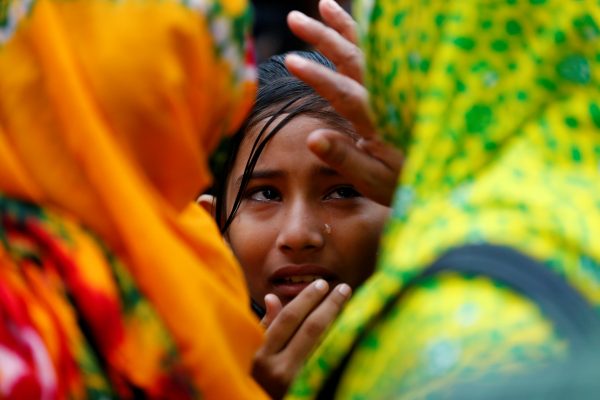The tragedy on 24 April 2013 killed 1129 and injured more than 2500 workers. In response, Western companies invested in two organisations: The Accord on Fire and Building Safety in Bangladesh created by European businesses and The Alliance for Bangladesh Worker Safety created by North American retailers. The brands declared that it was no longer going to be business as usual and that they would strictly monitor and inspect a portion of Bangladesh’s factories.
In the last seven years, registered factories in Bangladesh have been required by the Alliance and the Accord to comply with electrical, fire safety and structural standards. The factories covered by these monitoring agreements account for 27 per cent of total factories, since Tier 2 and 3 subcontracting factories are not monitored by these organisations. By 2018, 16 per cent of all Accord and Alliance registered factories had successfully completed the entire remediation process.
While the Accord spends US$11 million every year supporting engineers and monitoring staff, non-compliant factories did not receive any financial support to make necessary improvements. Smaller and under-resourced factories were simply terminated when they were not able to comply.
These agreements were successful in making a portion of Bangladesh’s factories structurally safer, but there has not been much progress in several other key areas. Garment workers in Bangladesh still do not get paid a living wage making it impossible to accumulate any savings. They face brutal crackdowns on their right to organise and bargain despite an initial increase in union registration after 2013. Brands adhering to the fast fashion business model continue to squeeze suppliers by setting unrealistic targets, continually demanding that they produce increased quantities faster and cheaper.
Since the Rana Plaza disaster, lead times have declined by 8 per cent, prices paid to suppliers have declined by 13 per cent and wages have dropped by 6 per cent. The reality in 2020 is worse than business-as-usual in 2013.
The emphasis on the physical building as the main culprit of the Rana Plaza disaster allowed for a narrow focus on improvements to infrastructure alone, while ignoring power inequalities between brands, suppliers and workers that have allowed this sector to flourish with low wages, poor working conditions and high profits.
Today, the industry is facing devastating consequences as a result of the COVID-19 pandemic. 2.7 million workers have been fired or temporarily suspended. Most have been sent home without pay and more than half of the garment factories have had to shut their operations. By the middle of April, buyers had already cancelled or postponed US$3.2 billion of garment orders from Bangladesh.
During this time of global upheaval, brands have used their unequal power positions with suppliers to justify cancelling or postponing orders and refusing to pay for orders that suppliers have already produced and materials that have already been procured, despite having a contractual obligation to do so. Brands have benefited from cheap labour from Bangladesh for decades but do not feel obliged to take care of those at the bottom of their supply chains. As a result, tens of thousands of garment workers in Bangladesh may die, not from COVID-19, but from starvation.
Brands have bought into the notion that necessary improvements to factories are better handled by third party monitors, rather than by labour groups or workers themselves. This has been a way to justify crackdowns on workers organising — struggles are deemed disruptive and unproductive for the industry and the country’s economic growth. Unfortunately little has changed in the last seven years to improve workers’ ability to bargain, negotiate and improve their conditions.
When garment workers in the Rana Plaza building noticed cracks early on, they were told to return to work in order to meet the demanding targets for that day. These workers — who were threatened with not receiving their wages or being fired if they left the building — were forced to return to a situation that eventually cost them their lives.
Seven years later, garment workers are still placed in the unenviable position of having to choose between their lives and maintaining their livelihoods. Many garment workers have been told to go back into their factories, even under a nationwide lockdown, or otherwise lose their jobs. This is a choice no one should have to make.
Unless there is meaningful change in the industry, there will be another disaster in the garment sector of unprecedented scale. Buildings that have been made safer over the last seven years may not collapse but if current practices by those at the top of global supply chains continue, the entire industry might.
Sanchita Banerjee Saxena is Executive Director of the Institute for South Asia Studies at the University of California, Berkeley, and Director of the Subir and Malini Chowdhury Center for Bangladesh Studies. She is editor of Labor, Global Supply Chains, and the Garment Industry in South Asia: Bangladesh after Rana Plaza (Routledge, 2020) and author of Made in Bangladesh, Cambodia, and Sri Lanka: The Labor Behind the Global Garments and Textiles Industries (Cambria Press, 2014).


It often forgotten how these garment exporters exploit their suppliers, using their unequal power position. Using the Covid -19 excuse , they are not paying for fabric and trims that were supplied to them much before the Covid -19 epidemic was reported, as far back as November 2019. Even after the Covid 19, the actual loss of garment exporters is not as high as its perceived. They are not paying their fabric and trim suppliers, whose input makes up approximately 60 per cent of the cost. Trims and fabric supplier factories also have employees, but having no association, makes their plight goes unremarked.